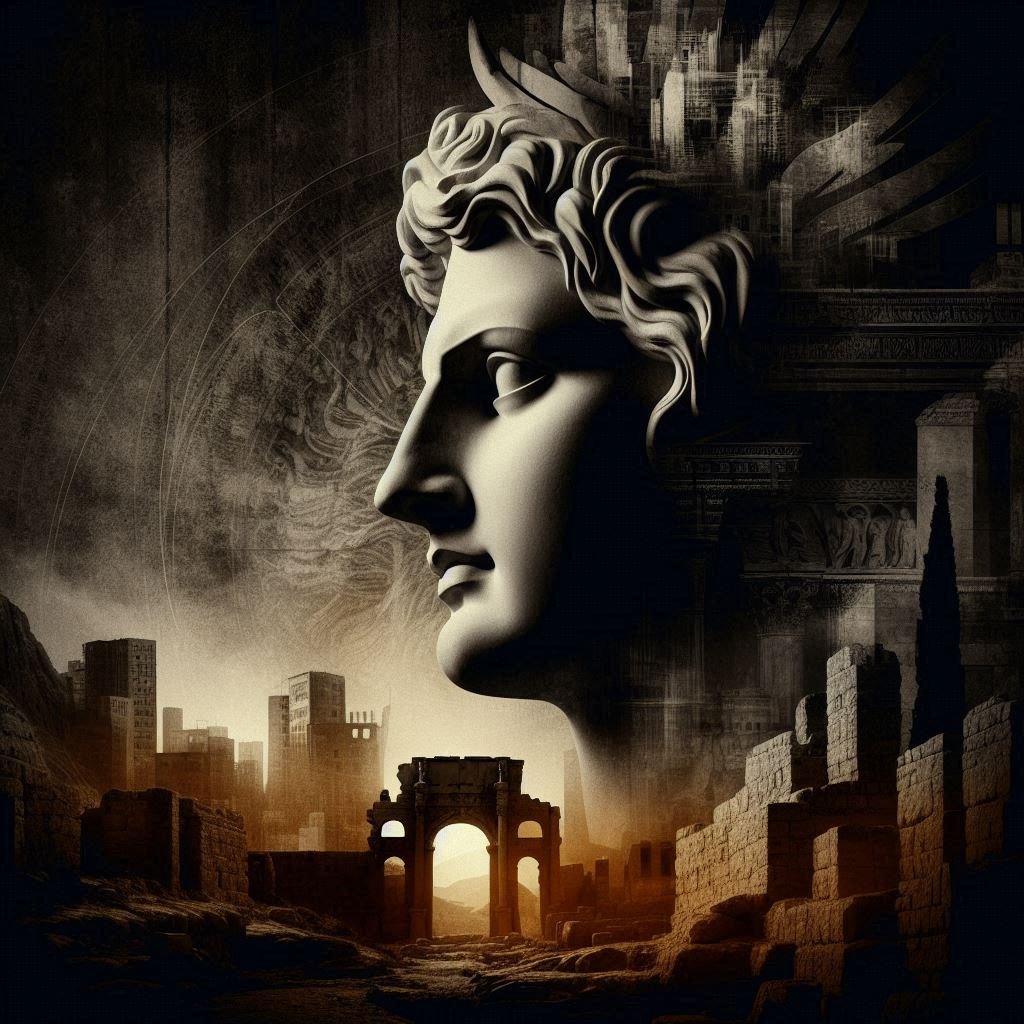Imagine this. You’re walking through the bustling streets of Alexandria, Egypt, nearly two thousand years ago. Vendors shout, children play, and the salt smell of the Mediterranean drifts in the air. But ahead of you, the noise fades. People bow their heads, step aside, and lower their voices. You’ve reached the most sacred spot in the city—the tomb of Alexander the Great.
Inside lies the man who conquered the known world before he even turned thirty-three. His body, perfectly preserved, rests in a golden sarcophagus, then sealed inside a second golden coffin. Over it is a crystal shell so that anyone—commoner or emperor—can look upon the face of the greatest conqueror in history.
For centuries, his tomb was not a myth. It was real. Roman emperors traveled to touch it, Cleopatra herself paid homage, and ancient writers described it in detail. But today, nothing remains. The shrine has vanished, the sarcophagus gone, and the body of Alexander—once the most famous relic on Earth—is missing.
So what happened to the tomb of Alexander the Great?
Death in Babylon
Our story begins in the summer of 323 BC. Alexander the Great, having marched from Greece to the edge of India, returned to Babylon with plans for even more conquests. He was only thirty-two years old, undefeated in battle, and seen by many as divine. But suddenly, he fell ill.
For days, Alexander lay in fever. Some accounts say he was poisoned, others that it was typhoid or malaria. He grew weaker until, finally, he was unable to speak. His generals filed past his bed, and he silently raised his hand in farewell. Soon after, Alexander was dead.
His empire stretched across three continents, but without him it was already crumbling. His generals would eventually fight bitter wars over his territories. But at that moment, there was only one question: what do we do with the body of the greatest man in the world?
The Golden Sarcophagus
Ancient accounts say Alexander’s body was placed inside a coffin of hammered gold, then sealed inside a second golden casket. Over that, it was encased in a crystal-like shell. Unlike other rulers, whose bodies decayed or vanished into cremation fires, Alexander’s was treated like a divine relic.
At first, his generals planned to return him to Macedonia, his homeland, to be buried in the royal cemetery at Aegae. A grand funeral procession began to carry his coffin west.
But then, something astonishing happened.
Ptolemy’s Theft
As the funeral cortege passed through Syria, Ptolemy—one of Alexander’s closest generals—intercepted it. He stole the body and brought it to Egypt. Why? Because to possess Alexander’s body was to possess his legacy. Whoever controlled the corpse could claim they carried on Alexander’s spirit.
At first, Ptolemy buried Alexander in Memphis, the ancient Egyptian capital. Later, the body was transferred to Alexandria, the city Alexander himself had founded on the Mediterranean coast. There, a shrine was built—called the Soma or Sema—to house his remains.
This wasn’t just a tomb. It was a beacon.
The Shrine of the Conqueror
For centuries, Alexander’s tomb was one of the most visited sites in the ancient world. Ordinary citizens came to pray. Pilgrims came to seek blessings. And rulers—men who controlled empires of their own—made the journey to gaze upon Alexander’s body.
Julius Caesar visited during his time in Egypt. Cleopatra, desperate to link herself to Alexander’s legacy, honored him. When Augustus, the first Roman emperor, came to Alexandria, he placed a golden crown upon Alexander’s head and scattered flowers at his feet.
The emperor Caligula allegedly stole Alexander’s breastplate and wore it himself. Caracalla, centuries later, draped the body in his own cloak. Even in death, Alexander was treated like a living god.
The historian Strabo, writing in the 1st century BC, described the Soma as a magnificent complex in the heart of Alexandria. Another writer, Suetonius, confirmed that Augustus had seen the body himself. This wasn’t myth. This wasn’t hearsay. The tomb existed, and everyone knew it.
The Vanishing
And then… silence.
By the 3rd century AD, the shrine was mentioned less and less. Riots shook Alexandria. Earthquakes damaged the city. Christianity spread across the empire, and pagan shrines were either destroyed or repurposed.
By the time the Arab historian Ibn Abdul al-Hakam visited Alexandria in the 9th century, locals pointed to ruins they claimed were Alexander’s tomb, but the body itself was gone.
Somewhere between late antiquity and the medieval era, the most famous grave on Earth simply vanished.
Theories and Legends
For nearly two thousand years, people have asked: what happened? The theories are endless.
Some believe the tomb was destroyed during riots in the 3rd or 4th century. If so, the golden sarcophagus would have been looted. But no such treasure has ever surfaced.
Others think the body was moved in secret. One persistent theory is that early Christians, hoping to protect Alexander’s remains, reburied him under the Church of Saint Mark in Alexandria. When Venetian merchants later stole Saint Mark’s bones and took them to Venice, were they actually stealing Alexander? Some even whisper that the body beneath Saint Mark’s Basilica today might not be the saint at all, but the world’s greatest conqueror.
Islamic tradition offers another twist. Some Muslims believed Alexander was the same figure as Dhul-Qarnayn, a mysterious king mentioned in the Quran. If true, then perhaps his body was hidden away deliberately, its location known only to a few.
And then there’s the most exciting theory of all: that the tomb is still there, intact, buried somewhere under the streets of modern Alexandria.
The Archaeological Hunt
Alexandria today is a sprawling city of five million people, built layer upon layer on ancient ruins. Much of the old city lies beneath modern streets and buildings, making excavation nearly impossible.
Still, explorers have tried.
In the 19th century, European archaeologists claimed to find underground chambers and ruins they thought belonged to Alexander’s tomb. Napoleon’s scholars during his Egyptian campaign reported hearing locals talk of a mysterious hidden sarcophagus.
In 1995, Greek archaeologist Liana Souvaltzi announced she had found the tomb in the Siwa Oasis, deep in Egypt’s western desert. She pointed to inscriptions and architecture she said proved Alexander had been buried there. But Egyptian authorities disagreed, and the claim collapsed.
Then, in 2019, a giant black granite sarcophagus was uncovered in Alexandria. The internet exploded with rumors—could this finally be Alexander? When opened, it revealed only three skeletons and rancid water. Once again, disappointment.
And yet, the mystery keeps calling.
Why It Matters
So why do people care so much? Because Alexander wasn’t just another ruler. He was a legend. He spread Greek culture across continents, founded dozens of cities, and changed history forever. His tomb was the physical symbol of that power.
Finding it today would be like discovering the tomb of Jesus, or the Ark of the Covenant. It would rewrite history books, settle debates, and unleash a flood of artifacts and knowledge.
But maybe the deeper reason is this: Alexander wanted immortality. He wanted to be remembered forever. And by vanishing, his tomb has granted him that in the strangest way. We can’t stop looking. We can’t stop wondering.
Ghosts in the Streets of Alexandria
Even now, in Alexandria, rumors swirl. Some say the tomb lies beneath the Nabi Daniel Mosque, where underground chambers remain off-limits. Others whisper it’s under the modern library, built on the site of the ancient one. Some claim it rests beneath a church, disguised as something else entirely.
Walk the streets at night, and you can almost imagine it: the conqueror lying in silence just beneath your feet, waiting for someone to stumble upon him.
The Final Question
Two thousand years ago, emperors stood before Alexander’s body and left offerings. Today, we can’t even say where he rests. Was he destroyed in riots? Stolen and reburied in Venice? Hidden beneath Alexandria’s crowded streets?
What we know is this: in life, Alexander conquered the world. In death, he may have conquered something even greater—the ability to remain a mystery.
So the question still lingers, whispered like a prayer and a curse: Where is Alexander?




